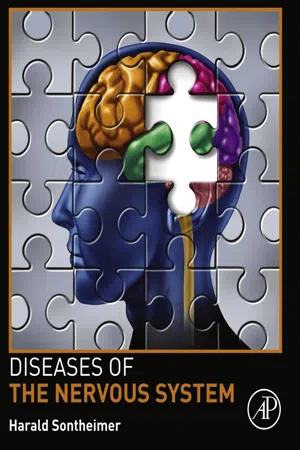
- 520 pages
- English
- ePUB (mobile friendly)
- Available on iOS & Android
Diseases of the Nervous System
About this book
The study of the brain continues to expand at a rapid pace providing fascinating insights into the basic mechanisms underlying nervous system illnesses. New tools, ranging from genome sequencing to non-invasive imaging, and research fueled by public and private investment in biomedical research has been transformative in our understanding of nervous system diseases and has led to an explosion of published primary research articles.Diseases of the Nervous System summarizes the current state of basic and clinical knowledge for the most common neurological and neuropsychiatric conditions. In a systematic progression, each chapter covers either a single disease or a group of related disorders ranging from static insults to primary and secondary progressive neurodegenerative diseases, neurodevelopmental illnesses, illnesses resulting from nervous system infection and neuropsychiatric conditions. Chapters follow a common format and are stand-alone units, each covering disease history, clinical presentation, disease mechanisms and treatment protocols. Dr. Sontheimer also includes two chapters which discuss common concepts shared among the disorders and how new findings are being translated from the bench to the bedside. In a final chapter, he explains the most commonly used neuroscience jargon. The chapters address controversial issues in current day neuroscience research including translational research, drug discovery, ethical issues, and the promises of personalized medicine.This book provides an introduction for course adoption and an introductory tutorial for students, scholars, researchers and medical professionals interested in learning the state of the art concerning our understanding and treatment of diseases of the nervous system.- 2016 PROSE Award winner of the Best Textbook Award in Biological & Life Sciences- Provides a focused tutorial introduction to the core diseases of the nervous system- Includes comprehensive introductions to Stroke, Epilepsy, Alzheimer's Disease, Parkinson's Disease, Huntington's Disease, ALS, Head and Spinal Cord Trauma, Multiple Sclerosis, Brain Tumors, Depression, Schizophrenia and many other diseases of the nervous system- Covers more than 40 diseases from the foundational science to the best treatment protocols- Includes discussions of translational research, drug discovery, personalized medicine, ethics, and neuroscience
Frequently asked questions
- Essential is ideal for learners and professionals who enjoy exploring a wide range of subjects. Access the Essential Library with 800,000+ trusted titles and best-sellers across business, personal growth, and the humanities. Includes unlimited reading time and Standard Read Aloud voice.
- Complete: Perfect for advanced learners and researchers needing full, unrestricted access. Unlock 1.4M+ books across hundreds of subjects, including academic and specialized titles. The Complete Plan also includes advanced features like Premium Read Aloud and Research Assistant.
Please note we cannot support devices running on iOS 13 and Android 7 or earlier. Learn more about using the app.
Information
Cerebrovascular Infarct
Stroke
Abstract
Keywords
Atherosclerosis; Embolism; Energy; Excitotoxicity; Ischemia; Thrombosis; Tissue plasminogen activator1. Case Story
2. History
Table of contents
- Cover image
- Title page
- Table of Contents
- Copyright
- Dedication
- Acknowledgments
- Introduction
- Part I. Static Nervous System Diseases
- Part II. Progressive Neurodegenerative Diseases
- Part III. Secondary Progressive Neurodegenerative Diseases
- Part IV. Developmental Neurological Conditions
- Part V. Neuropsychiatric Illnesses
- Part VI. Common Concepts in Neurological and Neuropsychiatric Illnesses
- Part VII. Bench-To-Bedside Translation
- Part VIII. Neuroscience Jargon
- Index